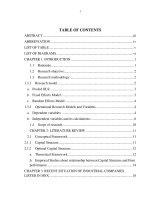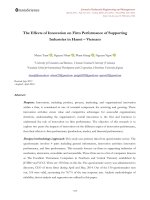Perspectives on the performance of the continental economies
Bạn đang xem bản rút gọn của tài liệu. Xem và tải ngay bản đầy đủ của tài liệu tại đây (3.89 MB, 511 trang )
Perspectives on the Performance of the Continental
Economies
CESifo Seminar Series
edited by Hans-Werner Sinn
Michael M. Hutchison and Frank Westermann, editors, Japan’s Great
Stagnation: Financial and Monetary Policy Lessons for Advanced Economies
Jonas Agell and Peter Birch Sørensen, editors, Tax Policy and Labor
Market Performance
Marko Köthenbürger, Hans-Werner Sinn, and John Whalley, editors,
Privatization Experiences in the European Union
Jay Pil Choi, editor, Recent Developments in Antitrust: Theory and Evidence
Ludger Woessmann and Paul E. Peterson, editors, Schools and the Equal
Opportunity Problem
Bruno S. Frey and Alois Stutzer, editors, Economics and Psychology: A
Promising New Field
Mark Gradstein and Kai A. Konrad, editors, Institutions and Norms in
Economic Development
Robert Fenge, Georges de Ménil, and Pierre Pestieau, editors, Pension
Strategies in Europe and the United States
Steven Brakman and Harry Garretsen, editors, Foreign Direct Investment
and the Multinational Enterprise
Reinhard Neck and Jan-Egbert Sturm, editors, Sustainability of Public Debt
Roger Guesnerie and Henry Tulkens, editors, The Design of Climate Policy
Stephan Klasen and Felicitas Nowak-Lehmann, editors, Poverty, Inequality, and Policy in Latin America
Gregory D. Hess, editor, Guns and Butter: The Economic Laws and Consequences of Conflict
Timothy Besley and Rajshri Jayaraman, editors, Institutional Microeconomics of Development
Paul DeGrauwe, editor, Dimensions of Competitiveness
Vivek Ghosal, editor, Reforming Rules and Regulations
Edmund S. Phelps and Hans-Werner Sinn, editors, Perspectives on the
Performance of the Continental Economies
See for a complete list of titles in this series.
Perspectives on the Performance of the Continental
Economies
edited by Edmund S. Phelps and Hans-Werner Sinn
The MIT Press
Cambridge, Massachusetts
London, England
© 2011 Massachusetts Institute of Technology
All rights reserved. No part of this book may be reproduced in any form by any electronic
or mechanical means (including photocopying, recording, or information storage and
retrieval) without permission in writing from the publisher.
For information about special quantity discounts, please email special_sales@mitpress.
mit.edu
This book was set in 10/13 pt Palatino by Toppan Best-set Premedia Limited. Printed
and bound in the United States of America.
Library of Congress Cataloging-in-Publication Data
Perspectives on the performance of the continental economies / edited by Edmund
Phelps and Hans-Werner Sinn.
p. cm. – (CESifo seminar series)
Includes bibliographical references and index.
ISBN 978-0-262-01531-8 (hardcover : alk. paper)
1. Europe, Western–Economic conditions–1945- 2. Economic indicators–Europe,
Western. I. Phelps, Edmund S. II. Sinn, Hans-Werner.
HC240.P383 2011
330.94–dc22
2010035922
10
9
8
7
6
5
4
3
2
1
Contents
Contributors vii
Series Foreword ix
1
Introduction: Gauging and Explaining Economic Performance
in Continental Europe 1
Edmund S. Phelps and Hans-Werner Sinn
2
Entrepreneurship in Europe and the United States: Security,
Finance, and Accountability 27
Roman Frydman, Omar Khan, and Andrzej Rapaczynski
3
Europe’s Venture Capital Institutions Are Good Enough
Richard Robb
4
Promoting Entrepreneurship: What Are the Real Policy
Challenges for the European Union? 91
Anders N. Hoffmann
5
Innovations to Foster Risk-Taking and Entrepreneurship
Robert J. Shiller
135
6
Europe: Cultural Adjustment to a New Kind of Capitalism?
Harold James
151
7
Venturesome Consumption, Innovation, and
Globalization 169
Amar Bhidé
8
Cyclical Budgetary Policy and Economic Growth: What Do We
Learn from OECD Panel Data? 223
Philippe Aghion and Ioana Marinescu
65
vi
Contents
9
Policies to Create and Destroy Human Capital in Europe
James J. Heckman and Bas Jacobs
10
Market Forces and the Continent’s Growth Problem
Gylfi Zoega
11
Controversies about Work, Leisure, and Welfare in Europe and
the United States 343
Robert J. Gordon
12
Revisiting the Nordic Model: Evidence on Recent
Macroeconomic Performance 387
Jeffrey D. Sachs
13
The Welfare State and the Forces of Globalization
Hans-Werner Sinn
14
Payroll Taxes, Wealth, and Employment in Neoclassical
Theory: Neutrality or Nonneutrality? 429
Hian Teck Hoon
15
Economic Culture and Economic Performance: What Light Is
Shed on the Continent’s Problem? 447
Edmund S. Phelps
Index
483
253
323
413
Contributors
Harvard University
Philippe Aghion
Harvard University
Amar Bhidé
New York University
Roman Frydman
Robert Gordon
Northwestern University
James Heckman
University of Chicago
Anders Hoffmann
Singapore Management University
Hian Teck Hoon
Bas Jacobs
FORA
Erasmus University Rotterdam
Harold James
Omar Khan
Princeton University
Columbia University
University of Chicago
Ioana Marinescu
Edmund Phelps
Columbia University
Andrzej Rapaczynski
Richard Robb
Jeffrey Sachs
Columbia University
Columbia University
Columbia University
Robert Shiller Yale University
Hans-Werner Sinn
Gylfi Zoega
CESifo
University of London
Series Foreword
This book is part of the CESifo Seminar Series. The series aims to cover
topical policy issues in economics from a largely European perspective.
The books in this series are the products of the papers and intensive
debates that took place during the seminars hosted by CESifo, an international research network of renowned economists organized jointly
by the Center for Economic Studies at Ludwig-Maximilians-Universität, Munich, and the Ifo Institute for Economic Research. All publications in this series have been carefully selected and refereed by members
of the CESifo research network.
1
Introduction: Gauging and Explaining Economic
Performance in Continental Europe
Edmund S. Phelps and Hans-Werner Sinn
Felix qui potuit rerum cognoscere causas.
(Happy is he who can know the causes of things.)
Virgil, Georgics1
At the Lisbon Summit of March 2000, the European heads of state
proclaimed their goal of making Europe “the most competitive and
dynamic knowledge-based economy in the world” by 2010. Now the
decade has come to an end and the transformation of the European
economy is not in sight. It is widely perceived by now that continental
western Europe has gone from catching up to falling back, its torpor
exceeded only by Japan. This was confirmed in the data of the past
dozen years when, in continental western Europe, GDP growth was
slower than that in any other region of the world, except for Japan
(figure 1.1).2 The underperformance in regard to productivity and the
performance in some other dimensions are the subject of this book.
What ails the economies of continental western Europe? Is it mainly
some deficiency in their economic system? Is it mainly some effect of
their welfare systems of social insurance and assistance: either the taxes
to pay for them or the entitlements themselves? Or are all these systems
healthy, even by advanced standards, yet weighed down by adverse
market prospects in the continental economies—notably, the Continent’s grim demographic future?
The state of Europe’s economies raises issues on which economists
have been divided for some time. Some adherents of neoclassical economic theory see no causal role at all for a country’s “economic system.”
They recognize a need for such legal institutions as rights to hold
wealth, from land to government bonds, and rights to contract one’s
labor for goods. They also recognize the convenience of facilities that
2
Edmund S. Phelps and Hans-Werner Sinn
180
170
Real GDP
Index, 1995=100
Developing Asia
136.1%
160
Middle East 74.1%
Eastern Europe
66.9%
World 57.7%
Latin America 48.5%
150
140
Africa 78.3%
Hong Kong, Singapore,
South Korea, Taiwan
72.5%
United States 44.3%
EU27 35.4%
130
120
Japan 17.2%
110
100
1995 1996 1997 1998 1999 2000 2001 2002 2003 2004 2005 2006 2007
Figure 1.1
Economic growth in selected regions and countries
reduce the transaction costs of borrowing from or partnering with other
investors. In their view, however, these and other arrangements spring
reliably into place: a country is able to evolve the economic system that
is best for it. The Panglossian view that market solutions are efficient
because they result from a competitive trial and error process is
extended by analogy to government institutions. With the economic
system of the Continent having been optimized, so far as one can tell,
no improvement can be expected from altering it. This may be named
the Rational Institutions theory.3
The same might be thought about a country’s social system. The
Continent could be supposed to have its reasons for its social insurance
and social assistance entitlements. Indeed some economists of neoclassical persuasion, including some at this conference, hypothesize that
the Continent has preferences for work and saving, and indeed economic institutions that are no different from those in a great many other
economically advanced countries; the primary difference, they say, is
that most people on the Continent have an outsized need for “security,”
which their welfare state is well designed to provide. Thus everything
in this world is for the best—or for Pareto efficiency, at any rate. There
is no free lunch. If institutions are to be changed, it will simply be a
matter of whose ox is gored.
Gauging & Explaining Economic Performance in Continental Europe
3
The methodology of this volume (and of the conference from which
it originates) holds that in a real-life society the economic institutions
are apt to be suboptimal. One of the reasons could simply be that institutional evolution is much too slow to adapt to changing challenges of
nature, markets, and knowledge to be able to even approximate the
optimum. Another is that the international competition for the best
institutional designs is far from a price mechanism that would enable
an Invisible Hand to find the optimal institutional solutions. In fact, as
Hans-Werner Sinn’s Selection Principle suggests, there is every reason
to expect market failure in systems competition. The Selection Principle
says that governments correct market failure and carry out activities
that cannot easily be handled by markets. Thus, if the market is reintroduced through the back door of systems competition, it is likely
to suffer from the same kind of market failure that caused the government intervention in the first place.4
Yet another reason is that no real-life society can know all the illeffects of the economic institutions it has and all the good effects of the
economic institutions it lacks, as Thrainn Eggertsson has argued.5 In
any society there is likely to be uncertainty (in the sense of Knight)
about the net benefit of some of its institutional innovations. There is
likely too to be Knightian uncertainty about any further innovation in
institutions. Thus a society may accept that there may well “exist” some
advantageous redesigns of its social systems, but is at sea over which
redesigns would deliver an overall improvement and which would not.
Another possibility is that the inefficiency of some of society’s institutions is not in dispute yet it goes on “irrationally” operating with its existing institutions because it cannot agree or muster a majority on which of
the less inefficient ones to select. So it is possible for political reasons as
well as cognitive ones that the Continent’s systems are “inefficient.”
Thus the Rational Institutions theory is not only lacking any foundation; it is highly objectionable as well.
1.1
Comparative Evidence on Economic Performance
Most seasoned and expert observers of the economies of the West—
roughly those of the member countries of the OECD—have the impression that most, if not all, of the ones in continental western Europe have
performance characteristics that are worse on the whole than do the
economies in the rest of the West. It is worthwhile to check such perceptions against the evidence.
4
Edmund S. Phelps and Hans-Werner Sinn
Let us consider the unemployment rates in 1995 and 2007. The data
suggest that unemployment rates tend to be higher on the western
Continent than the usual comparator countries outside the Continent:
Finland, Sweden, Canada, United Kingdom, and United States (see
table 1.1). Data on labor force participation rates in the same two
periods also suggest a tendency toward less participation on the Continent than in the comparator countries. The difference between the
former group, comprising most of the western Continent, and the comparator group could be interpreted as reflecting differences in the
mental stimulus, intellectual challenge, and other attractive features
found in jobs in the one group and the other. That is, after all, one of
the reasons why we are interested in unemployment and nonparticipation: the data tell us something about people’s identification with their
work and with the market system as such.6
There is direct evidence, however, on how rewarding, relatively
speaking, is the employee experience on the Continent. Personal
accounts by employees and journalists describe a workplace that is
quite stultifying.7
Table 1.1
Unemployment rate and participation rate of men and women in G10 countries
excluding Japan
Country
Unemployment
rate in 1995
Unemployment
rate in 2007
Participation
rate men
2006
Participation
rate women
2006
63.9
France
9.9
8.0
74.2
Germany
7.1
6.4
81.4
68.5
11.3
5.9
74.6
50.8
Italy
Netherlands
6.8
3.3
81.9
69.4
Spain
18.7
8.1
82.5
61.1
Eurozone without
Sweden, Denmark,
United Kingdom
10.0
6.8
79.3a
64.2a
Canada
9.5
6.0
82.2
73.5
Finland
16.7
6.6
76.2
73.2
Sweden
7.7
4.6
82.6
77.7
United Kingdom
8.6
5.5
83.2
70.3
United States
5.6
4.6
81.9
69.3
Source: OECD, Economic Outlook 1982, Employment Outlook 2007.
a. EU 15.
Gauging & Explaining Economic Performance in Continental Europe
5
A few household surveys collect evaluations of employees in a large
number of economies (table 1.2). A highly reputed survey supports
the view that the continental workplace is relatively unrewarding.
The data on reported “job satisfaction” show a clear and significant
difference between the levels on the Continent—particularly France,
Germany, Spain, Italy, and the Netherlands—and the levels in most of
the comparator countries: Denmark, Sweden, Canada, Iceland, and the
United States.
A difficulty with the satisfaction data is that respondents who do
not regard themselves as “very satisfied” may mean that they feel they
are underrated or unjustly treated by their employer. The respondents
may not have been thinking of fulfillment, self-actualization, or selfrealization. For this reason it is good to have reported “job involvement,” or employee engagement, which we may presume to be more
about the job than the employee. The ranking of the countries in this
respect suggests that France, Germany, Italy, and the Netherlands are
low, relatively speaking, in job involvement—thus low in mental stimulation and intellectual challenge. France and Germany, which are so
Table 1.2
Indicators of economic performance in the G10 from world values surveys: Job
satisfaction and employee engagement
Country
Job
satisfaction
Job satisfaction
index
Employee
engagement
Employee
engagement index
Canada
7.89
0.76
2.70
0.85
France
6.76
0.00
1.74
0.00
Germany
6.98
0.15
1.79
0.04
Italy
7.26
0.34
2.03
0.26
Japan
7.66
0.61
2.20
0.41
Netherlands
7.48
0.49
2.16
0.37
Spain
7.02
0.18
2.31
0.50
Sweden
7.93
0.79
2.63
0.79
United Kingdom
7.42
0.45
2.80
0.94
United States
7.84
0.73
2.87
1.00
Note: Job satisfaction is measured on a scale from 1 to 10, 10 being the highest, and
employee engagement (degree of pride derived from the job) is on a scale from 1 to 3, 3
highest; both are averaged for 1990 to 1993 (Human Beliefs and Values, Inglehart et al.,
Ann Arbor: University of Michigan Press, 1997). The job satisfaction index and the
employee engagement index scores are mapping the job satisfaction and employee
engagement measures onto the interval [0, 1].
6
Edmund S. Phelps and Hans-Werner Sinn
sophisticated, are at the bottom. The French Revolution and German
Socialism still cast a long shadow.
A very familiar indicator of economic performance in a quite different dimension is hourly productivity. The more esteemed variant is
total factor productivity. (A country might manage to have a higher
hourly productivity than another but only by means of having saved
much more or by somehow having borrowed overseas much more
against future income—either one coming at the cost of past or future
consumption, and those differences could mask the lesser efficiency or
greater technological backwardness of the former economy.) Yet there
are elements of arbitrariness in the adjustment made to go from labor
productivity to total factor productivity.8 Furthermore official estimates
of factor productivity levels, as distinct from growth rates, are unobtainable. An investigator is forced to “roll his own.”
With regard to hourly productivity, it is widely acknowledged that
by the middle of the 1990s several countries on the Continent had
reached levels in the neighborhood of the highest levels found in the
comparator countries. This is shown in table 1.3 But the usual perforTable 1.3
Productivity comparisons
Country
Hourly
productivity
level 1995 at
current $
prices and
OECD PPP
Hourly
productivity
level 2006 at
current $
prices and
OECD PPP
Hourly
productivity
index 2006
at constant
prices
(base 1995)
GDP per person
in working
age 2006 at
current prices
and OECD PPP
(1,000$)
France
32.2 (41.7)
50.1 (57.2)
120.9
47.8 (54.6)
Germany
31.9 (41.9)
47.1 (52.0)
120.3
48.2 (53.2)
Italy
29.6 (30.5)
38.1 (41.6)
105.6
43.5 (47.5)
Netherlands
33.6 (40.2)
51.5 (57.5)
113.7
54.5 (60.8)
Spain
26.8 (24.9)
39.3 (37.5)
106.7
42.5 (40.6)
Eurozone without
Sweden, Denmark,
United Kingdom
29.4 (34.5)
43.4 (47.0)
116.2
46.4 (50.3)
Canada
27.5 (24.3)
41.4 (43.8)
119.0
53.4 (56.5)
Finland
26.5 (34.6)
41.1 (50.1)
130.0
49.1 (59.8)
Sweden
28.4 (37.3)
44.7 (55.5)
133.7
53.2 (66.1)
United Kingdom
25.3 (25.5)
41.4 (49.6)
126.0
49.8 (59.6)
United States
31.5
50.4
126.2
64.8
Note: Figures in brackets are at the current exchange rates.
Gauging & Explaining Economic Performance in Continental Europe
7
mance indicators in nearly all the continental economies are now poor
compared with the other countries in the G7. The Big Three—Italy most
markedly, Germany and, to a lesser extent, France—steadily lost ground
to the United States owing to their slowdowns and the US speed-up
early in the present decade. In Germany hourly productivity sank to
93.5 percent of the US level in 2006 from 101.2 percent in 1995. Of
course, it would give a biased picture to compare with the US level
only the levels on the Continent of the standout countries—France,
Germany, and the Netherlands. Those countries’ levels might better be
compared with the levels in California, New York, and Pennsylvania.
In the same spirit one might compare with the average level in the
United States the average level in the continental part of the eurozone.
This ratio had sunk to 86.1 percent by 2006 from 93.3 percent in 1995
(see table 1.3).
Some caution in the interpretation of the data is warranted, however,
insofar as international differences of production patterns make unambiguous comparisons difficult.9 The purchasing power parities that are
used to make national currency values comparable and to eliminate
exchange rate volatility are very sensitive to the composition of the
commodity baskets used for the calculations. As a rule, a country’s
productivity appears higher in international comparisons if this country’s commodity basket is chosen to calculate the purchasing power
parities. (In 2006, for example, the PPP based on the German basket
was 1.34 dollars for the euro, while it was 1.15 with the OECD basket
and 0.92 with the US basket.) Thus indexes of the growth rate of productivity may have greater reliability. However, as the third column of
table 1.3 shows, since 1995 the hourly productivity numbers in the
continental European countries all increased less than in the countries
in the control group, with the slight exception of Canada, which is
outperformed by France. Thus these indexes give the same impression
gained by looking at the absolute values.
A further comparison, shown in the last column of the table, refers
to GDP per person of working age. This comparison confirms and
strengthens the impression of European backwardness gained by
looking at the productivity figures. France, Germany, and Italy are
outperformed by every single one of the comparator countries by a
wide margin. The huge gap in productivities could be explained by
Europeans’ preference to work less and enjoy their leisure time, but it
is more likely the result of inflexible wage structures that create more
open and hidden unemployment in Europe.
8
Edmund S. Phelps and Hans-Werner Sinn
As table 1.1 shows, even the open unemployment rates in Europe’s
Big Three are much higher than in the comparator group. A high rate
of unemployment usually results from a high degree of wage rigidity.
The rigidity can be due to strong union influence or due to the explicit
or implicit minimum wages resulting from legal minimum wages or a
welfare state that pays generous wage replacement incomes. The latter
interpretation is supported by table 1.4, which shows that France
and Germany suffer from record levels of unemployment among the
unskilled. Both countries have strong welfare states that defend high
minimum replacement incomes.
To the extent that low employment is not a result of individual
choice but of institutional rigidities, GDP per person in working age
shows Europe’s deficiency even better than hourly productivities.
While hourly productivities can be increased by simply increasing
wages and wiping out the less productive parts of the labor force, GDP
per person capture the deficiencies in the wage formation process. Only
this measure avoids gauging a mere selection effect.
The impact of wage rigidities on European performance has declined
a bit in recent years. Table 1.5 shows that the wage gap between the
Continent’s Big Three and the comparator countries declined from 1995
Table 1.4
Unemployment rates among the G10 excluding Japan in 2005
Country
Total (%)
Less than higher
secondary
educationa (%)
France
8.8
12.4
Germany
9.1
20.2
Italy
7.8
7.7
Netherlands
4.9
5.8
Spain
9.2
Eurozone without Sweden,
Denmark, United Kingdom
8.4
Canada
6.8
9.8
Finland
8.4
10.7
Sweden
5.8
8.5
United Kingdom
4.8
6.6
United States
5.1
9.0
9.3
na
Source: OECD Economic Outlook Database, OECD Employment Outlook.
a. Persons aged 25 to 64.
Gauging & Explaining Economic Performance in Continental Europe
9
Table 1.5
Wage costs per hour at OECD $PPP
Country
Wage cost 1995
Wage cost 2006
France
20.8 (27.0)
25.6 (29.3)
Germany
20.3 (26.7)
27.8 (30.7)
Italy
20.7 (21.3)
24.8 (27.1)
Netherlands
20.8 (24.8)
30.2 (33.7)
Spain
16.0 (14.8)
20.3 (19.4)
Eurozone without Sweden,
Denmark, United Kingdom
na
na
Canada
16.3 (14.5)
na
Finland
16.1 (21.0)
24.0 (29.2)
Sweden
na
na
United Kingdom
16.5 (16.6)
26.9 (32.2)
United States
19.3
29.7
Note: Numbers in brackets show wage costs at current exchange rates.
to 2005. Europe’s labor costs used to be much higher, but measured at
PPPs or exchange rates alike, they are now roughly in line with those
of the comparator countries.
It might be asked why, especially in the twenty-first century, many
economists in weighing the performance of an economy place huge
emphasis on productivity as measured by the quantity of output delivered at the end of the sausage machine. Indeed a provisional finding
of happiness research is that, beyond some point, a higher productivity
level is not conducive to greater “life satisfaction.”10 One would suppose
that the quality of the business experience—conceiving products to
produce, the adventure of developing a product, the challenge of
evaluating and using new products, and so forth—has become critical
to the reward gained from participation in the economy. One answer,
no doubt familiar, is that higher productivity makes it affordable for
society to pursue new collective goals that would otherwise be too
expensive, such as public programs aimed at adding to longevity and
tax credits aimed at increased integration of the disadvantaged into the
market economy.
Another answer is that a higher level of productivity makes it possible for a larger number of people to be able to earn the wage they
need to be able to afford to opt for jobs offering mental stimulation and
challenge. For this reason it is important to add another indicator of
10
Edmund S. Phelps and Hans-Werner Sinn
performance: the compensation of labor, out of which comes the paycheck and the “social contributions” for the employee. The wage data
here suggest that hourly total compensation on the Continent has sunk
ever farther than productivity has in the past ten years. The gross
hourly wage has sunk farther below the US level—more than has productivity (at constant prices). This strengthened the competitiveness of
European workers but came with substantial work dissatisfaction
(tables 1.3 and 1.5).
What conclusion does this collection of evidence suggest?11 It
appears reasonable to infer that the western Continent is not structured
for the appreciably higher economic performance found outside
the Continent and that there are one or more serious faults in the
Continent’s economic system(s) or social system(s), or both, gauged
against the best-performing (though undoubtedly imperfect) systems
in use outside the Continent—a statement that is not about social
manners, high culture, clothes sense, behavior of children, treatment of
the elderly, and much else.
This proposition, whether true or false, has nothing to do with the
current growth rate of the economy (or the growth rate of productivity)
in any period. It is a proposition about the potential of the economy as
it is structured at a specified time to deliver, under given circumstances,
low unemployment, to induce high participation, to offer high job
satisfaction and job involvement, and, finally, high levels of productivity. Yet the first reaction to this proposition before taking adequate time
to think about it is to say, “how implausible, since this is essentially the
same economy that delivered spectacular prosperity, employee engagement and the rest during the ‘glorious years’ from 1955 to 1975.” The
error in logic is to judge the economic performance of a country under
spectacularly advantageous circumstances against the performance of a
comparator country (or countries) under normal conditions. In those
“glorious years,” the dust of World War II had just settled and Europeans were America’s low-wage competitors that succeeded in playing
the card of absolute cost advantages and swimming in its slip stream.
Also Europe experienced rapid population growth with hoards of
young and energetic people entering the labor markets.
Europe must also have gained by being able to imitate new technologies from those of the United States. While the United States had benefited largely from the influx and capture of talent and know-how
before and after World War II, Europe, being deprived of its leading
position during the war, was eventually able to recoup. The low-hang-
Gauging & Explaining Economic Performance in Continental Europe
11
ing fruit of unexploited technologies overseas was abundant outside
the Continent. All these forces operated to cause rapid growth and high
employment for about twenty years. These forces spent themselves,
however. By the end of the 1970s wealth on the Continent was fully
recovered, the low-hanging fruit was mostly gone, and absolute cost
advantages had disappeared due to revaluations and extremely rapid
wage increases. With normal circumstances prevailing from the 1980s
onward, the Continent’s lackluster performance characteristics, which
had been masked, were visible to the naked eye.
Still, the idea that economic performance is seriously deficient on
the European Continent—and with respect to both dynamism and
inclusion—might surprise many readers of the essentially classical
histories of the twentieth century. It was a given—from Max Weber to
David Landes and Jared Diamond—that Europe was the discoverer of
an economic and social system that propelled it into economic development. And it seemed clear that the Continent was ahead in terms of its
scientific achievements. The question was how the Europeans did it.12
In much popular commentary the continental economies are still seen
as unexcelled. So there appears to be a paradox to reckon with. The
paradox is easily resolved, though. Although the Continent got a jump
on other countries in finding economic development of a sort, countries
outside the Continent soon adopted similar economic systems and
found comparable development, a few by 1800, such as England, some
others by 1900, such as the United States. In this latter period most
countries experienced further evolution of their economic systems,
generally for the better. The rudimentary system of Venice and Florence
in the 1300s, Germany’s and northern Europe’s Hansa trading system
from 1150 to 1650, and Luther’s mass education system had allowed
only a rudimentary capitalism at best. While that early period saw the
rise of pioneering entrepreneurs (of the Schumpeterian kind) and
perhaps some Hayekian conceptual originators, the capital came mostly
from kings, princes, dukes, and barons rather than from a whole industry of rival banks lending the people’s wealth, so the system bore only
a rudimentary resemblance to Anglo-Saxon finance-capitalism. Even if
the Continent managed to avoid misguided or unfortunate moves
causing structural damage to its economies, it was possible that its
systems would be surpassed by others. Other economic histories—
modernist histories in which national decisions may result from misjudgments (i.e., a wrong model) or from uncertainty (e.g., “unanticipated
consequences”)—argue that in the twentieth century the Continent did
12
Edmund S. Phelps and Hans-Werner Sinn
make some very misguided moves with consequences yet to be fully
assessed. Friedrich von Hayek, having Britain in mind, warned of
losses in political freedoms and in valuable economic freedoms that a
country risks from adopting the “socialist” or “totalitarian” thinking
that took hold in “Nazi Germany” and “Fascist Italy”—from the “naïve
trust in the good intentions of the holders of totalitarian power.”13
Herbert Giersch saw many of the vaunted reforms on the Continent in
the twentieth century as taking Germany back to the medieval guild;
others have questioned the wisdom of labor union representation in
the supervisory boards of corporations.14 More recently various economists have made neoclassical, supply-side criticisms of the Continent’s
outsize welfare-state entitlements and resulting payroll taxes, its redistributive taxation, its lifetime unemployment benefits, minimum wage
laws, and so forth.
These essentially modern critiques by Hayek and Giersch, while
stimulating, did not go on to explain how the losses in economic freedoms could cost countries something in terms of economic performance—
job satisfaction, employee engagement, unemployment, participation,
and productivity.15 Much the same can be said of the latter-day criticisms of the Continent of a neoclassical character. Moreover many
European economists counterargue that their corporatism works well:
the role of unions brings offsetting benefits in heightened solidarity and
personal security, which are valuable in their own right, and they in
turn boost participation and productivity as well.16 Furthermore the
relational banking works well too, and there is competition in the
product market. Many Europeans also contend that their welfare state
is harmless because it is financed with fiscal efficiency and because it
promotes the health of workers. Existing efforts to resolve empirically
some of these questions have been few. So there is a crying need to
develop the various theses and test them against data.
This volume is an effort at understanding and confronting with data
the various constituent ideas in the thesis of structural underperformance characteristics of the continental economies—perhaps the first
such effort. Part I, after weighing the premise that there are deficiencies
in the relative economic performance on the western Continent, asks
whether a perception of such a decline reflects only adverse market
conditions and adverse market prospects now afflicting several western
continental economies—not any underlying differences in economic
institutions, social policy or economic culture. Part II addresses ideas
pointing to a weakening in the performance of the institutions of the
Gauging & Explaining Economic Performance in Continental Europe
13
economic system. Part III addresses some of the ideas behind the thesis
that the problem lies in the social system imposed on the economy
rather than in the economic system itself. Part IV looks into the possibility that the problem with the economic system is not so much its
economic institutions as it is the cultural attitudes that have taken
root in the Continent’s workplaces. (This was the sequence in the 2006
conference.)
1.2
Market Forces: Demographics, Wealth, and Capital
An interesting idea introduced by Robert Gordon into the Venice conference is that the western continental economies have been struck
with relatively high unemployment as a result of large increases in
the working-age population, mainly coming from eastern Europe. The
impact has been an immediate increase in the absolute number of
persons in the labor force even if participation rates did not increase
(although the new workers are disproportionately young, the participation rate has been pushed up as well). But since finding a desirable
job opening takes time, the interim effect is a rise of the unemployment
rate. At the same time, with the entry of foreign workers less skilled
initially than the nationals, we should expect hourly productivity to
head down toward a lower path.
Whether this interpretation, inspired by one subset of the evidence,
runs into trouble or gains support by looking at other evidence is hard
to judge. Consider the evidence on investment goods purchases. One
would think that the influx of new workers would stimulate investment in new plants and equipment. And, the boost to investment
expenditure would be short but sharp while the boost to consumption
expenditure would be small but sustained. These effects do not appear
in the data, however. But perhaps other forces intervened.
One explanation is that Europe’s welfare states offer high social
replacement incomes for domestic residents.17 These replacement
incomes act as lower bounds on wages and prevent the creation of
additional jobs for the migrants, such that there is immigration
into unemployment. However, as the immigrants are not entitled to
welfare, they take the jobs, and the domestic residents who remain the
marginal suppliers in the domestic labor market are crowded out into
the welfare system.
A complementary explanation, one derivable from Phelps’s work in
the 1990s, focuses on the impressive pileup in the continental countries
14
Edmund S. Phelps and Hans-Werner Sinn
of private wealth relative to wages. After the “glorious years” of
rapid growth (starting in 1955) were over and the continental wealthincome ratio had reached cruising level—sometime around 1980—it
was a great deal higher than it had been in 1955. The crucial
point, however, is that continental households are phenomenally
thrifty. As a result the relatively high ratios on the Continent are easily
the highest in the OECD. It can be argued that these high levels of
private wealth weigh down heavily on the supply of labor, thus male
and female participation rates, and have serious ill-effects on employee
behavior as well, which in turn push up the natural rate of
unemployment.18
An analysis tying the Continent’s slump to its thrift suggests a
straightforward test. That is to say, we should expect to find countries’
labor force participation rates negatively associated with their ratio of
private saving to GDP; and their propensities to quit and shirk, thus
also the rate of involuntary unemployment, positively associated. In
fact, in the OECD economies, which are highly open to foreign capital
flows, we do find evidence of such associations—statistically significant
evidence (see Zoega, chapter 10 in this volume).
If slower ex post productivity growth, even when unaccompanied
by slower expected growth, operates to increase the wealth-to-wage
ratio, then in narrowing participation rates and pushing up the unemployment rate, we should also expect to see that those continental
countries that have suffered relatively slow growth among the OECD
members suffer relatively high unemployment and low participation,
other things equal. There is some support for these associations. Since
the early 1990s, Germany, France, and Spain have had slower productivity growth than Sweden, Ireland, and Iceland; the former countries
have also had higher unemployment and somewhat lower participation than the latter countries.
Of particular note are the sharp productivity slowdowns that struck
several economies in modern memory—Holland from 1995 onward,
Germany from 1996, Spain from 1997, and lastly France and Italy from
2001. These contrast mightily with the productivity speedup of Ireland
after 1999 and that of the United States, Finland, Korea, and Japan after
2002. The slowdowns were generally followed by increases in unemployment rates—Holland 6.3 percent in 2005 from 4.2 percent in 1998,
Germany 10 percent from 8.7 percent, Switzerland 4.1 percent from 3.4
percent, Luxembourg 4.6 percent from 3.1 percent, France 10 percent
from 8.7 percent in 2001.









